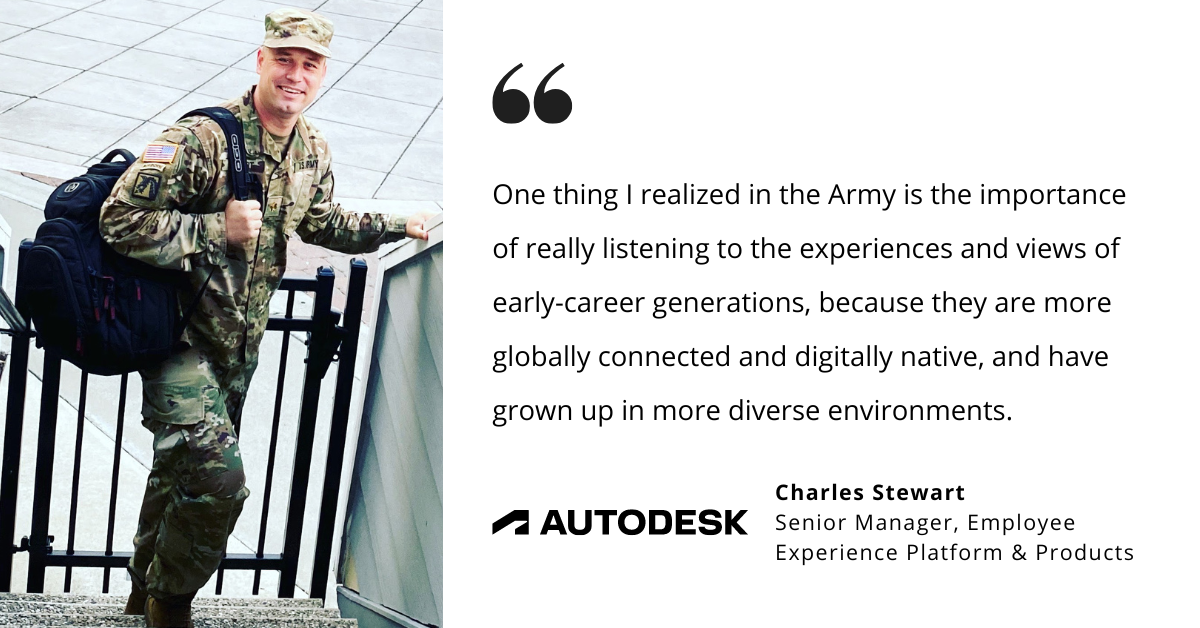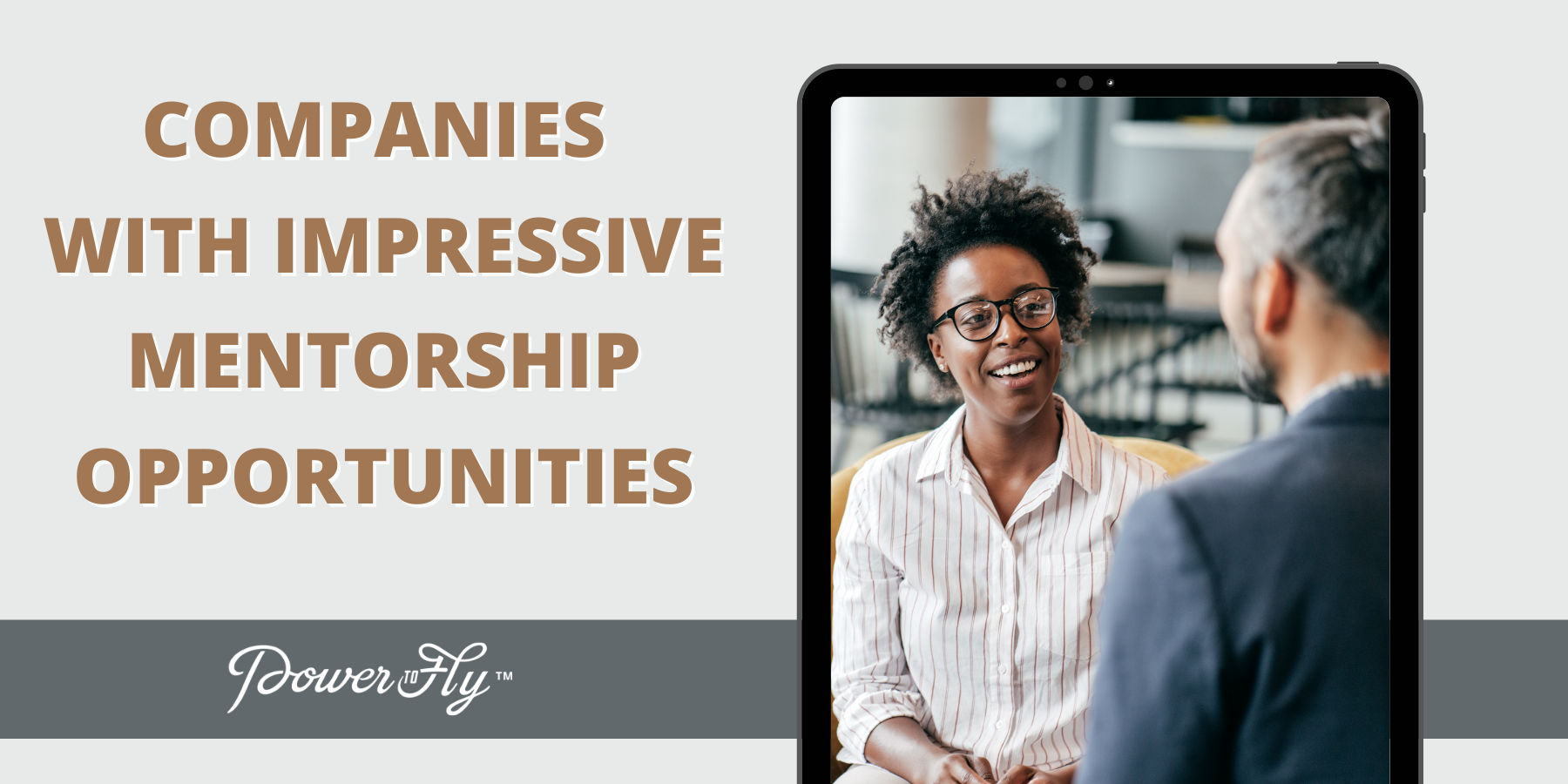Whether it’s creating a visual aid to help explain a concept, celebrating Latinx Heritage month, or taking the time to mentor Gen Z-ers, Charles Stewart is constantly looking for ways to connect with people and create inclusive digital spaces.
His passion for human connection shines through everything he does—from his work advocating for fellow military veterans, to advising on the US soldier and candidate digital experience as an Army Reserves member, to the products he builds as a Senior Manager at Autodesk. We sat down with Charles to hear about his experience moving from the military to the tech world and his advice on how to build globally inclusive digital workplaces.
From Army Officer to Product Manager
As a nineteen-year-old when 9/11 occurred, Charles decided to enlist in the Army and served in countries like Iran, Iraq, Kuwait, and Qatar.
He’s a visual person with a knack for communicating his experiences in a way that others can see what he means, like when he likens his Army experience to that of Forrest Gump. “I was a soldier, a private, like Forest Gump, cleaning the bathroom with a toothbrush, that was my job. Then I experienced the opportunity to go to college, so through the Army, I got social mobility.”
During his military service, he completed both his bachelor’s in History and MBA all while being deployed twice. Charles recalls that serving in the Army opened the doors to understanding the diverse backgrounds in the U.S. and around the world.
“Being on a team that looked like our multicultural country made us learn about each other and respect each other to work better—whether we had a rural or urban background, whether we were Asian, Black, White, or Indigenous,” he says.
When Charles left active duty to be with his wife in the Bay Area, he joined a veteran transition program at a tech company. This allowed him to work with tech professionals, learn from their backgrounds and experiences, and ultimately connect him with the people who would help him fully transition into a tech role.
“It was a mixture of gaining capabilities and fluency, as well as identifying sponsors and mentors who would say your name when you're not in the room. I know exactly who those people were for me and I'm still thankful to them.”
During this time, Charles transitioned from program management to product management, taking on projects like creating AI digital tools, working as Global Lead of Veterans for an ERG, and soon after, accepting a position at Autodesk as Senior Digital Product Manager.
Creating an Inclusive Digital Workplace
Charles' two favorite aspects of his work are innovation and community. “I get to create technology that connects people,” he says, highlighting the power of creating digital tools that have the potential to be used by thousands.
At Autodesk, he creates digital products that help new hires acclimate to the company. Not only that, he makes sure that his work contributes to making new hires feel welcome, no matter who they are.
“I really want everyone to have a terrific work experience and feel seen and valued in the workplace. I think your digital experience is really important. Like when you log in, do you see pictures of people that look like you in your workplace? Do you see your country highlighted? Do you see your holidays highlighted? Things like that really matter,” he points out.
Charles takes the time to hear from all possible users, especially the younger generation. “One thing I realized in the Army is the importance of really listening to the experiences and views of early-career generations, because they are more globally connected and digitally native, and have grown up in more diverse environments.”
Inspired by his experience in the Army, Charles searches for ways to incorporate the younger generations’ perspectives, specifically Gen Z-ers, to better create digital workplaces.
Giving Back to the Community
Charles recognizes the immense impact his time in the Army had on his life. “I'm really thankful for the Army in that period of my life because I didn't have people investing in me or believing that I could be 23 years old and lead 24 soldiers in Baghdad. That was mentoring in the institution,” he says.
While acknowledging his own privilege, he also draws inspiration to give back to the community from his experience transitioning to civilian life and, specifically to the tech world. He explains, “It’s about paying it forward for the folks that created opportunities for me. I'm very aware that I don't think my progression into Product or my promotions would've been as quick if I didn't look the way I did too. So that's another reason why I really try to show up in that space.”
In line with his passion for creating inclusive digital workplaces, Charles continues to be a part of the Army Reserves where he uses his tech knowledge to advise on the US soldier and candidate digital experience.
He also teaches product management at the University of Washington and serves as a mentor for a program entirely focused on communities underrepresented in the field, such as women, Black, Latino, Indigenous, and veterans.
8 Ways to Create Globally Inclusive Digital Workplaces
According to Charles, building a globally inclusive digital workplace requires cultural competency and intentionality. In this era of technological revolution, it’s key to analyze how digital processes are being structured and platforms built.
While Charles emphasizes that he’s still learning how to create this workspace of the future, he offers these eight practical ways to improve cultural competency and create a more globally inclusive digital workplace:
- Have a Zoom coffee chat with a colleague. “Get to know the people you work with to see your teammate not just as somebody that creates amazing code, but has unique, complex life experiences and a point of view about the digital experience and what works for them.”
- Attend a cultural event. “Whether in or outside of the workplace, attend events that will help you get to know other communities better.”
- Join an Employee Resource Group (ERG). “ERGs are global in their composition. You have teammates that may come from other countries. Are you curious about them and their experiences and recommendations?”
- Read. “Not everyone can afford to travel. Most people can afford to read.”
- Consider social media. “Platforms like Tik Tok are doing a good job of connecting people across cultures.”
- Account for how change impacts all people. “Before you make major changes in your digital employee experience, who are you listening to to see how it'll land or be received?”
- Pay attention to language expectations. “Are you only building a workplace for the native English speaker? What language, words, and sentence structures are you using? Is it approachable or are you excluding people? Does it feel like you're creating a space where you have to be perfect in English to speak up and share your ideas?”
- Vary your meeting structure. “Is it all verbal inputs or do you have an opportunity to encourage written inputs? Are you tracking speaking time in the meeting?”
Are you interested in joining Autodesk’s inclusive team? Check out their roles here.




